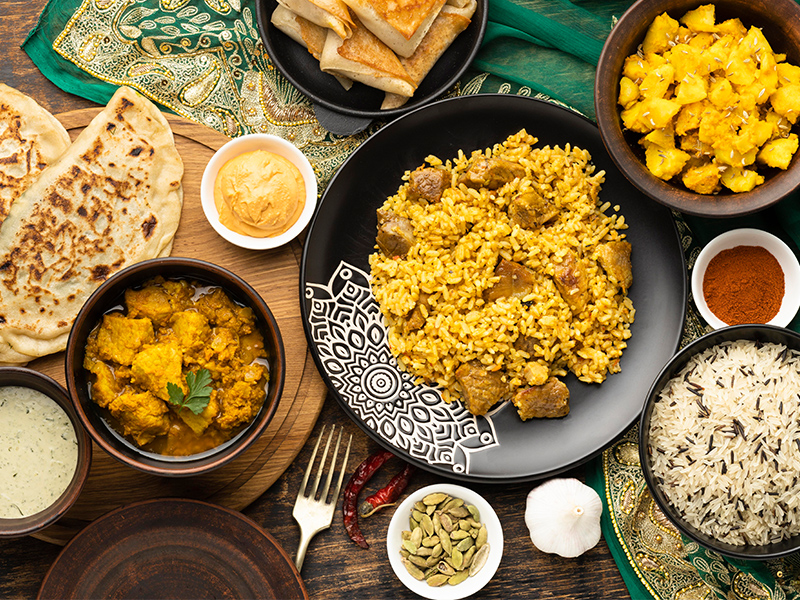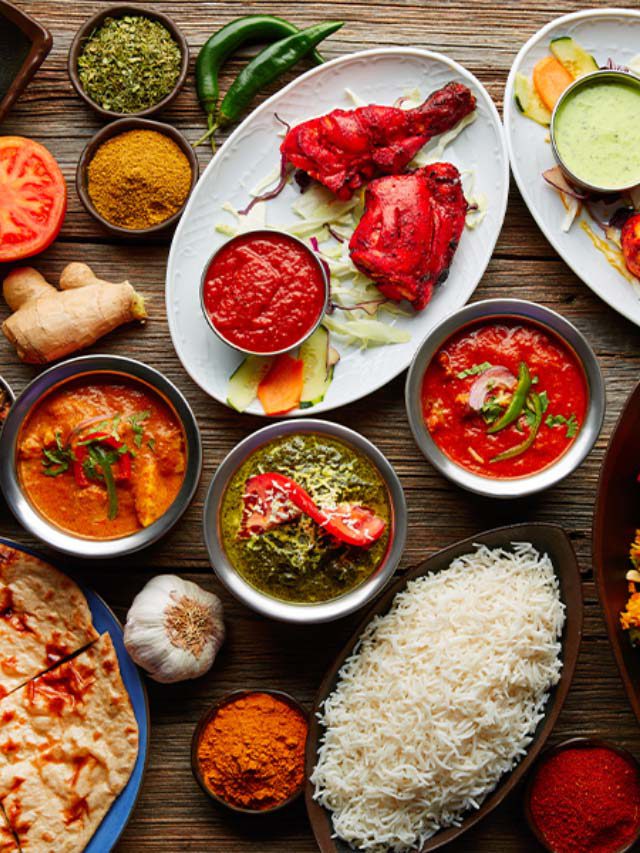Indian cuisine is a perfect blend of a variety of dishes and ingredients, full of colour, taste and obviously, packed with nutrients. There is a variety of dishes coming from various parts of the country, be it south, north, east or west, one common custom that prevails is the ‘Indian thali’. Indian thali is a traditional plate, with about 10 various types of dishes that are accompanied by pickles, yoghurt and other condiments.
Thali is served during festivals, weddings and is an important part of India’s culture. The food served can range from a leaf to a silver platter, depending on which part of India you are in. But one common thing is that the food is highly nutritious, doesn’t matter what place it comes from.
TC46 connected with Senior Nutrition Therapist Minal Shah of Fortis Hospital, Mumbai to highlight the health benefits of an Indian thali, how it is prepared and why it is considered to be most nutritious.
1. The opportunities to include different rainbow coloured food in a thali are endless
The presence of a rainbow on the plate is due to the presence of different nutrients and phytochemicals, which makes the meal attractive and healthy.
- Red: Comes from Lycopene which fights cancer and protects the heart
- Orange & Yellow: Comes from the beta-carotene that converts to vitamin A plays a major role in reducing the risk of cancer of lungs, esophagus and stomach
- Brown: Comes from the beans, lentils, due to the presence of Folate that counteracts Homocysteine which forms blood clots
- Green: Vegetables are a powerhouse of nutrients like vitamin K, folic acid, carotenoids and fibre which is heart-friendly and has anti-cancer roles to play
- Blue & Purple: These are Anthocyanins are antioxidants and have an anti-inflammatory benefit, and can help alleviate complications in type-2 diabetes, and may improve eye health
- White: These foods also have multiple roles to play like support bone health, lower cholesterol levels, reduce inflammation, and protect against certain types of cancers
The opportunities to include different coloured food in a thali are endless, making it appealing and equally nutritious.
2. There are different healthy components of a good thali
A traditional Indian thali offers different flavours like sweet, salty, bitter, sour, spicy, and astringent which is nutritionally balanced. Different regions have different versions of the thali, generally comprising traditional dishes and native specialities with local and seasonal ingredients. A thali includes a cereal preparation (rice, chapati, puri, bhakri), dal (dal or sambar or kadhi), vegetables (dry or curries), curd or raita or buttermilk, salad or kachumber, pickle or lemon, papad, chutney (sweet or spicy), followed by a dessert. A non-vegetarian thali will have an additional chicken dish or fish curry or mutton dish preparation.
3. All varieties of Indian thalis have native and region-specific delicacies
All varieties of Indian thalis have native and region-specific delicacies, influenced by their culture and history. Also, these dishes were made depending on their climate, work pattern, availability of ingredients and traditions.
- North India: It has Kashmiri thali which has royal and exquisite meat-based preparation and has dry fruits in almost every dish. Himachal Pradesh has an assortment of herbs and spices. Punjabi and Haryanvi thali has a rich quotient of homemade ghee, curd, and butter with farm-fresh ingredients. Kumaoni thali from Uttarakhand is simple and seasonal with food cooked in mustard oil. Thali from Uttar Pradesh is influenced by Mughlai and Awadhi cuisine filled with specialities like biryani, kebabs, petha, kachori and more. Rajasthani thali is considered the quintessential Indian thali with highlights of bajra, jowar and makka roti and extensive use of besan.
- West India: It has Gujarati thali which has a subtle and sweet taste to its preparations and mostly vegetarian meals with an assorted variety of snacks. Maharashtrian thali is extremely spicy and has unique masalas with coconut and red chillies as the main ingredient. Chicken and fish are the common non-veg items you’ll find here. They have a great variety of pickles. Goan thalis have the hottest curries with seafood, rice, coconut, and kokum as the main ingredients.
- South India: It comprises Karnataka, Andhra Pradesh, Telangana, Kerala, and Chettinad or Tamil Nadu thali and is served on a banana leaf, rich in ghee, rice-based, with spicy lentil curry, with coconut and a pickle and non-vegetarian preparation. Andhra thali usually ends with perugu (curd rice). Telangana has no concept of desserts. Kerala cuisine has abundant coconut oil and coconut milk. Tamil Nadu or Chettinad has its own signature dishes with even offerings of munchings like banana chips and chakli.
- East India: It has Dalma Oriya thali which emphasizes copious amounts of vegetables and restrained use of spices and oil. It is among the healthiest thalis in India. Bengali thali is a fish lover’s thali and ends with a sweet note of payesh and rosogulla. Bhojpuri thali is predominantly vegetarian, and Jharkhand has a similar speciality with an extra non-vegetarian platter to offer. All the thalis end with a dessert.
- Central India: Chhattisgarh thali stands out with its variants of bread like Angakar Poori, Paan Roti and Chusela, a typical meal consisting of rice and rice flour preparations. The vegetarian cuisine in Madhya Pradesh has the influence of Gujarat and Rajasthan in it. Poha and Shikaji (thick malaidar milk with nuts) are specialities of Madhya Pradesh.
- Northeast India: It has the Manipuri (or meitiei) thali. It is simple, tasty and centred around fish, seasonal vegetables and sticky rice. A traditional Aalohir Exaj or the Assamese meal begins with a delicacy called Khar, which is a curry made with raw papaya, lentils, and powdered dry banana skins. The meal ends with a signature Assamese preparation Tenga, a lightly spiced sweet and sour fish curry. The Sikkimese thali is a foodie’s delight which includes momo’s (steamed dumplings), Thukpa (noodle soup), Gundruk (fermented leafy green vegetables), Chhurpi ka achaar (Yak Cheese pickle), Ningro curry (fiddle-head curry gravy), Sel roti (doughnut-shaped bread). Meghalaya thali is considered to be very healthy. Black sesame is used in almost every dish.
All the variations North, South, East, and West are near equal as the components in terms of the food groups and nutrients composition are similar, the difference lies in the style of combining it and the preparations
4. The Indian thali has all the food groups combined
The thali does have all the food groups combined in varied preparations in a meal. Let’s list the food groups to understand this better.
Food groups and different preparation or components of thali are as follows:
- Cereal: They forms the basis of an Indian thali with preparations like rice, wheat chapati, bajara, rice, jowar bhakri, bati from dal bati churma, missi roti, khichdi, paratha, kulcha, poita bhat, pulao, biryani, poee and more. Learn about the nutritional value of two commonly consumed grains, wheat v/s jowar here.
- Pulses: They are made as different dals, kadhi, usal, pithla khar, sambar, dholka, kothimbir vadi, bhajiya, thovve, huli, gatte ki sabzi and more.
- Vegetables: They are an integral part of cuisines as curies, dry veg preparations, salad.
- Fruits: They are equally included in a traditional thali with a variation as amras, amrakhand, banana sheera, pineapple sheera, sithaphal basundi, petha, mango lassi, aam panna, or a simple elaichi banana.
- Oil or fats: Indian thalis or cuisine are rich in oil or fats as a cooking medium and top-up. We have an array of sources like ghee, vanaspati, various oils like groundnut or mustard or sesame of coconut or sunflower or soya bean and rice bran oil. Dry and fresh coconut, coconut milk, groundnut, oilseeds like sesame, cashew, charmagaz (almonds, cantaloupe, watermelon and pumpkin seeds), almonds that are used in various gravies are also rich fat sources.
- Milk and milk products: They are another indispensable part of the thali in Indian cuisine, included as masala milk, buttermilk, paneer, shrikhand, rasgulla, rasmalai, mishti doi, phirni, payasam and many more.
- Egg, meat and meat products: In Indian thalis, they have some rich and variant non-vegetarian preparations like butter chicken, fish curry, egg curry, mutton kolhapuri (spicy mutton curry), pandhra rassa (chicken in white gravy), prawn caldine curry, pork vindaloo, machher jhol, masor tenga (light fish dish), rogan josh (lamb-based dish), yakhni (yoghurt-based mutton gravy).
5. The requirement of macro and micronutrients are fulfilled in a thali
The requirement of macro and micronutrients are fulfilled in a thali provided the variations are modified according to the season. An Indian thali beautifully combines the carbohydrates, proteins, and fats in its food preparation like a very simple dal-khichdi to a complex dish as biryani or dal bati churma. The vegetable and fruit preparations take care of the rest of the micronutrients needed to meet the daily nutritional requirements. Also, in a vegetarian meal, the combination of cereal pulse makes the second-class dal or pulse protein a complete protein, thus enriching the meal. Fluid requirements are also met in a thali by including liquids like buttermilk, masala milk, rasam, sol kadhi, lassi and more.
6. An Indian thali lunch is customisable
An Indian thali can very simply be made by including one or two servings of any cereal or Indian bread, one bowl of any dal, one or two vegetable preparations, a bowl of salad or kachumber, a bowl of curd or raita or buttermilk with healthy coriander (pudina chutney), lemon pieces, and a non-vegetarian dish or curry for a non-vegetarian meal. Other components like pickle and papad can be optional, as per individual requirements and medical history. Similarly, desserts can be included if made in a healthy manner as per the person’s medical history and nutritional requirements.
7. A healthy Indian dinner thali can be assembled at home
A healthy Indian dinner thali will have similar components as lunch, but it can be assembled in a different manner. A roti-veg can be replaced with veg paratha or veg pulao, rice-dal can be replaced with khichdi or dosa or uthappam, or an entire meal can be replaced with a one meal dish like muthiya with buttermilk, dal dhokli, rice and sambar with buttermilk, paneer paratha with green chutney, chicken biryani with raita or chakoli or tukde.



